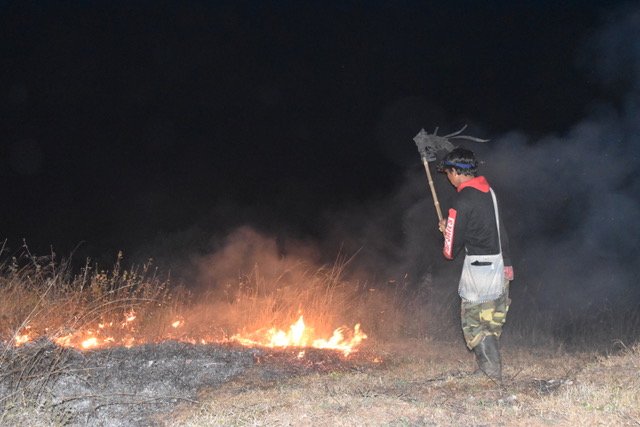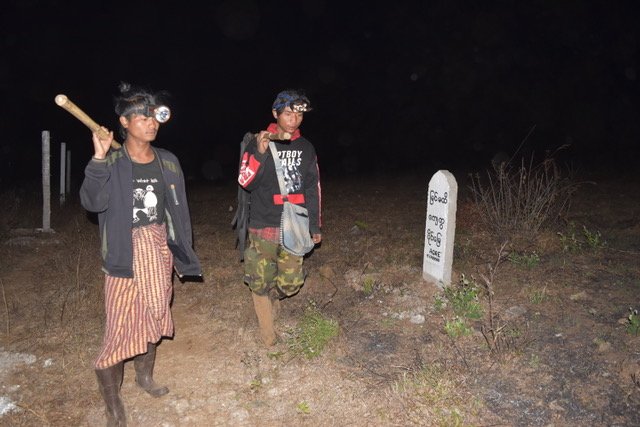ACRE Update — January 2023
Happy January from ACRE! Since our last report in October last year, we have left the monsoon rains behind us and moved into our first dry season. We have since seen the team downscale in size, with tasks becoming less complex. We've also made major progress toward involving two renowned international NGOs, The Nature Conservancy and RECOFTC, who made visits to our site. Their potential support could mean significant enhancements to the scientific rigour and credibility of our operations, which are crucial to success.
Operations
From a maximum size of 40 workers at the height of the planting season in August, the team is now down to 9 permanent staff, consisting of 4 Guards, 1 Supervisor, 1 Administrative Officer, 1 Maintenance Officer and 2 Managers. Their tasks revolve around patrolling, maintaining the plants and the equipment, and protecting the integrity of the site’s borders.
Fire fighting
The threat of a fire wiping out the progress we’ve made in reforesting our site in minutes is very real. The root cause is the “slash and burn” culture. Since the beginning of agriculture millennia ago, the populations that have occupied Shan State mountains have been burning their fields during the dry season to “fertilise” them, before planting them again at the beginning of the monsoon season. While this may have been conducive to productivity and natural regenerative cycles in the past, it’s now been made obsolete by technologies like fertiliser, and made worse by changing climate patterns and land use. But how do you change centuries of embedded cultural practice? And who are we to lecture them when they have been the victims of climate injustice and globalisation?
It’s only been a month since the area around Myinmethi was plunged into a smoky fog. It’s so intense that it makes breathing difficult. And it’s so often that when you look out from our hilltop, there’s a good chance that you can see small fires dotted throughout the landscape, radiating out in all directions.
We identified fire as a key risk from ACRE’s onset, and so we had our team working hard from November to December, right from when rains stopped, to establish “fire fences” in areas we identified as critically important (see below). Most at risk were the piles of vegetal waste (like rice husk or corn stems).
We have had some incidents despite our measures, including an incident where a local farmer, without warning, set a loaf on fire. It spread quickly, but was eventually quelled.
Another recurring issue we have is hunting. Although local wildlife was already scant from immense pressures, we still have continued to witness night hunts conducted by the villagers. Their targets include small rabbits, big rats, pheasants, turning to the usual tactic – fire, to draw them out of hiding.
The most serious incident saw us losing 25 saplings in a fire and we have since learnt plenty from the incident. So far, our night guards have successfully contained 4 fires that have threatened our plantation. Here’s a short video of one firefighting effort.
Weed-cleaning and fire-fencing
Our guards on day-shift are assigned routine maintenance – this includes creating the “fire-fences” that have been instrumental to the protection of the plantation.
A fire fence is a 3- to 5-metre wide band of barren land that isolates our plantation. This is to protect the spread of an external fire by limiting its fuel supply (in vegetation) at our borders, insulating our plantations. We also test it by burning it after clearing to make sure it works. We can’t completely seal off our sites however with our plantation including 3 distinct enclaves, representing 5 km in perimeter. Here we establish physical fences where the danger of fire spreading is highest.
Day-duty guards are also assigned the task of clearing weeds and high grass. They use a brushcutter, which is a powered agricultural tool used to trim weeds, small trees, and other foliage. During the first year after outplanting the seedling, it is necessary to clear all weeds every 3 months, to reduce competition and give the seedling best chance to grow healthily. We calculated that, with the accessible area planted spanning roughly 50 acres (the rest has been sowed with seeds), covering 0.60 acre (0.15 ha) will result in the guards coming back to their original starting point after 90 days of patrolling.
Night patrols and biodiversity
Having now passed the project’s planting phase, we’ve decided to focus on the protection of our site. We’ve since repurposed our planters to guard our site. Totalling 4 out of our 9 total employees, they patrol our site in shifts, with two on duty at all times. While the day pair usually occupy themselves by cutting weeds and routine maintenance as mentioned above, the night pair can usually expect more interesting things coming their way…
Despite our site only being 2 km from Myinmethi, our patrol guards have reported feeling unusually isolated during their night patrols.
At 1,500 m above sea level, winter can be harsh in the Shan State, at least relative to tropical latitudes. Our pair of guards move quickly in the 5ºC air to warm themselves.
In one area still covered with soft soil, they have grown accustomed to seeing an abundance of new wildcat tracks, hypothesising that they may have noticed its security from the fires that have been ravaging the local landscape. Is it possible that positive effects have manifested so quickly? We’d like to believe so. If anything, it shows that we’ve made steps in the right direction.
But it isn’t the cold remoteness or wildcats that get to our guards the most: it’s snakes. Not all snakes are nocturnal, but our serpentine friends in Myinmethi are. Learning from the minor incident we had in July, our guards now wear high rubber boots, to which they admit feel strange, coming from a culture of wearing flip-flops year-round. Unfortunately for our guards, Myinmethi’s snakes, like its wildcats, have taken refuge en masse at our site from local wildfires as well…
Maintenance
The brushcutters, used by our day-shift guards for weed-cleaning need regular and proper maintenance. To ensure that our equipment lasts as long as possible, we make preventative efforts to replace all bearings and axles before the machine starts vibrating and problems start to become more serious. This way, we cut down on costs as well as the resources that go into our project.
Another equipment that needs care is our light truck. The long winter period of relative inaction is the ideal opportunity to look deeper and maintain systems such as the ram of the dumpster. We’ve also repurposed the truck to help bring otherwise inaccessible water to the most disadvantaged members of the water-parched Myinmethi community.
Landmarks
Since the coup d’état that happened nearly 2 years ago (1/02/21), one of the few positive side effects has been the rise of Kalaw as a domestic tourist destination. Historically Kalaw was an exclusive altitude resort reserved for the English who occupied Myanmar and for the local elite. From 2011 onwards, the demographic shifted to foreign tourists who came mainly for the trekking, while local visitors remained low.
The coup changed this and nowadays Kalaw is almost the only destination in Myanmar where it’s difficult to book a hotel room.
A side effect of this is that the price of the land in surrounding villages has skyrocketed, as rich vacationers from Yangon have snapped up plots to build second homes for themselves.
Myinmethi, located only 5 km (bee line) from Kalaw, has similarly seen land pressures arising from this trend. Drawing from successful community forest practices, we established clear border demarcations for our reforestation project. For this we’ve made ourselves new “landmarks” and positioned them everywhere where our new neighbours could become greedy.
Budget
The operational budget has been greatly reduced since November, and we’re spending roughly US$1,000 per month (except main repairs). We have halved the salary to Managers, with their consent of course, as their presence is not needed every day.
Cooperation with The Nature Conservancy and RECOFTC
Last October, the directors of The Nature Conservancy (TNC) and RECOFTC visited our site and we discussed the possibility of officially supporting the programme.
While nothing has been signed yet, discussions have reached highly granular levels, and we have received confirmation that TNC’s regional management has submitted to their own central decisional committee a proposal for a grant of US$35,000 to ACRE for the season of 2023-24. If all goes well, we should receive confirmation of the funding by April 2023.
TNC would also provide funds to RECOFTC (The Center for People and Forests), an NGO with presence across Southeast Asian community forests, to educate, organise and train the villagers of Myinmethi, as well as to register the land of the project under the Community Forest status provided by Myanmar’s Law.
We would like to assure existing investors that this is a grant, and not equity. The partners who have invested in the ACRE programme will therefore not see their share diluted. On the contrary, existing investors will benefit greatly from the additional security (and scientific research, see below) provided by TNC’s financial support.
Our next priorities
In the discussions we had with RECOFTC and TNC, we have decided to use part of the grant to conduct research and testing with local forest species.
Our first step will be to compile and integrate past research that may have taken place at the Kalaw Reservoir Forest reserve to identify a source for our seedlings. Back in the 19th century, the British had designated a 16 ha area of forest as a reserve to protect an artificial lake that provided Kalaw with fresh water. In the past 150 years however, this reserved forest has shrunk to 4 ha, a quarter of its former area. As the only intact primary forest close to our site, it is therefore the ideal source for locally-sourced seeds.
The composition of this forest also represents an important academic trove as to what mix of trees would work when we reintroduce local species into our plantations in two years’ time. It’s highly important that we respect the proportion and the order (emergent, canopy, understorey, and forest-floor species) that they are reintroduced so that they can thrive alongside each other.
Finally, we’d like to stress the importance we place on tracking animal biodiversity at our site. We’ve made some mention of wildcats and snakes frequenting our site, but so far we haven’t implemented systems to monitor wildlife. This is because we made the decision to prioritise investing in research, planning, and planting. We would however, in the event that resources are surplus, introduce systematic protocols to survey and analyse wildlife occurrences to showcase the difference we’re making. We’ll be sure to share our findings here when we do.
We shall send our next report the week after the Burmese New Year (13th April). Thanks for reading, and stay tuned!













